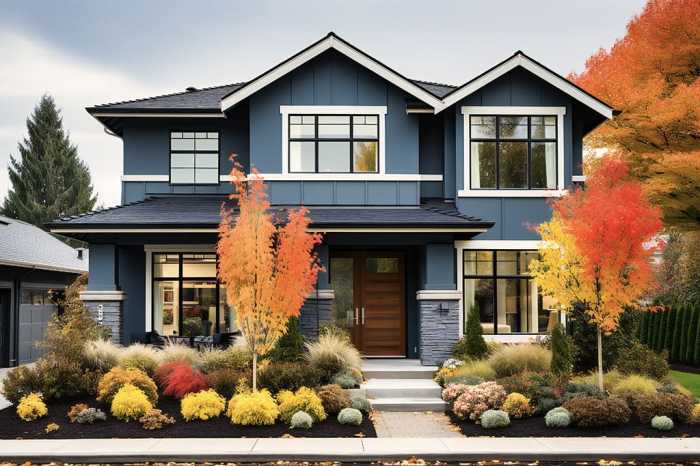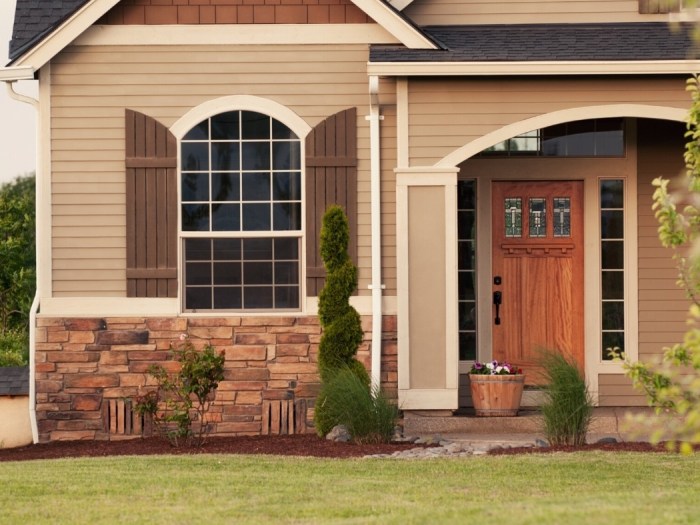Residential Exterior Painting Trends You Need to Know
As Residential Exterior Painting Trends You Need to Know takes center stage, this opening passage beckons readers with informative insights into the latest color trends, finishes, and technologies shaping the world of exterior painting. It promises a deep dive into sustainable practices, technological advancements, and the age-old debate of DIY versus professional services, ensuring a comprehensive guide for homeowners and enthusiasts alike.
Trends in Residential Exterior Painting
When it comes to residential exterior painting, staying up to date with the latest trends can help you create a modern and stylish look for your home. Let's explore some of the current trends in residential exterior painting.
Current Color Trends
Choosing the right color for your home's exterior can make a big impact on its overall appearance. Some popular color trends for residential exterior painting include:
- Neutral tones such as gray, beige, and taupe for a timeless and sophisticated look.
- Dark and moody hues like navy blue or forest green for a dramatic and modern touch.
- Earthy tones like terracotta or olive green for a more natural and inviting feel.
Popular Finishes and Textures
The finish and texture of the exterior walls can also play a significant role in the overall aesthetic of your home. Some popular finishes and textures for exterior walls include:
- Smooth finishes for a sleek and contemporary appearance.
- Textured finishes like stucco or brick for added dimension and visual interest.
- Metallic finishes for a modern and industrial look.
Incorporating Accent Colors
Accent colors can be used to highlight architectural features or add personality to your home's exterior. Here are some ways accent colors are being incorporated into exterior painting schemes:
- Using a bold accent color on the front door for a pop of color and visual interest.
- Painting window trims or shutters in a contrasting color to create a striking contrast.
- Adding accents in unexpected places, such as on porch railings or decorative trim, to make a statement.
Sustainable Painting Practices
When it comes to residential exterior painting, sustainable practices are becoming increasingly popular due to their eco-friendly nature. Homeowners are now opting for environmentally conscious options that not only enhance the look of their homes but also reduce their carbon footprint.
Eco-Friendly Paint Options
One of the key aspects of sustainable painting practices is the use of eco-friendly paint options. These paints are made from natural and renewable materials, such as plant-based or mineral-based ingredients, making them safer for both the environment and human health.
- Low-VOC or Zero-VOC Paints: These paints contain minimal or no volatile organic compounds (VOCs), which are harmful chemicals that can off-gas into the air and contribute to indoor air pollution. By choosing low-VOC or zero-VOC paints, homeowners can improve indoor air quality and reduce their exposure to toxic substances.
- Benefits of Low-VOC or Zero-VOC Paints: In addition to being better for the environment and health, low-VOC or zero-VOC paints also offer excellent coverage, durability, and color options. They are just as effective as traditional paints, without the negative impact on air quality.
Sustainable Painting Techniques
Aside from using eco-friendly paint options, sustainable painting techniques can further reduce the environmental impact of residential exterior painting projects. These techniques focus on minimizing waste, conserving resources, and promoting energy efficiency.
- Proper Surface Preparation: By properly preparing the surfaces before painting, such as cleaning, sanding, and priming, painters can ensure better paint adhesion and longevity. This reduces the need for frequent repainting, saving both time and resources.
- Water-Based Paints: Water-based paints are another sustainable option that offer easy cleanup, low odor, and fast drying times. They are also less harmful to the environment compared to solvent-based paints, making them a popular choice for eco-conscious homeowners.
- Energy-Efficient Tools: Using energy-efficient tools, such as paint sprayers with low overspray and LED lighting for nighttime painting, can help reduce energy consumption during the painting process. This not only lowers utility costs but also minimizes the carbon footprint of the project.
Technology and Innovation in Exterior Painting
Technology continues to revolutionize the residential exterior painting industry, offering new possibilities and efficiencies for homeowners and painters alike. Innovative tools and equipment are transforming the painting process, while virtual tools are providing a way to visualize exterior paint colors before application.
Innovative Tools and Equipment
- High-volume, low-pressure (HVLP) sprayers are becoming increasingly popular for their ability to apply paint more efficiently and evenly, reducing overspray and waste.
- Robotic painting systems are being developed to automate the painting process, increasing speed and precision while minimizing human error.
- Self-cleaning paint brushes and rollers are now available, making cleanup easier and reducing the amount of water and chemicals needed for maintenance.
Virtual Tools for Visualizing Exterior Paint Colors
- Virtual reality (VR) and augmented reality (AR) tools allow homeowners to see how different paint colors will look on their home before making a final decision, helping them choose the perfect shade with confidence.
- Online paint visualizers and mobile apps enable users to upload a photo of their home and experiment with different colors in real-time, making the selection process more interactive and convenient.
- Digital color-matching devices can scan existing paint colors on a home and recommend matching or complementary shades, ensuring a cohesive and harmonious exterior color scheme.
DIY vs. Professional Painting Services

When it comes to residential exterior painting, homeowners often face the decision of whether to tackle the project themselves or hire professional painting services. Each option has its own set of advantages and disadvantages, depending on factors like time, cost, and expertise.
Advantages and Disadvantages of DIY Exterior Painting
- Advantages:
- Cost-effective as you won't have to pay for labor.
- You have full control over the project from start to finish.
- Can be a rewarding and satisfying experience for those who enjoy hands-on work.
- Disadvantages:
- Time-consuming, especially if you lack experience or skills.
- Quality of work may not match that of professional painters.
- Risk of making mistakes that could lead to costly repairs in the future.
When to Hire Professional Painting Services
- If you have a large or complex exterior painting project that requires specialized equipment or techniques.
- When you want a professional finish with guaranteed quality and durability.
- If you lack the time, skills, or confidence to complete the project to your satisfaction.
Tips for Homeowners Considering DIY Painting Projects
- Invest in high-quality paint and tools to ensure better results.
- Properly prepare the surface by cleaning, sanding, and priming before painting.
- Take your time and work in manageable sections to avoid rushing and making mistakes.
- Protect surrounding areas with drop cloths and painter's tape to prevent accidental spills or splatters.
Last Recap
In conclusion, exploring Residential Exterior Painting Trends You Need to Know unveils a world of possibilities where color, sustainability, technology, and expertise converge to redefine the art of exterior painting. Whether you're a DIY enthusiast or seeking professional services, staying informed about these trends is key to transforming your residential exteriors with style and innovation.
Popular Questions
What are the current color trends for residential exterior painting?
Popular colors for residential exterior painting include muted blues, earthy greens, and warm neutrals. These tones are versatile and can complement various architectural styles.
What are the benefits of using low-VOC or zero-VOC paints?
Low-VOC and zero-VOC paints reduce harmful emissions, improving indoor air quality and promoting environmental sustainability. They are also safer for occupants and painters during application.
How is technology influencing residential exterior painting trends?
Technology is revolutionizing exterior painting with virtual tools that allow homeowners to preview colors, innovative equipment that enhances efficiency, and smart solutions for better results.
When is it best to hire professional painting services for residential exteriors?
Professional painting services are recommended for complex projects, intricate designs, or when precise finishes are required. They ensure a high-quality outcome and save time for homeowners.
What are some tips for homeowners considering DIY painting projects?
Prepare surfaces properly, use high-quality tools and materials, follow best practices for safety, and start with a small area to test colors and techniques before tackling the entire project.




